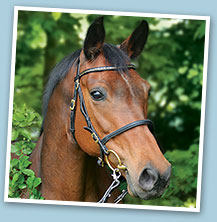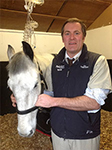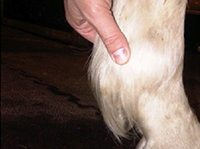
Press room
2014 press releases
Posted: 01/04/14
Lower Limb Lameness

The lower limb of a horse is a structure that is constantly working and is often put under a lot of stress. Therefore it can be prone to many conditions preventing us from being able to work and compete our horses. With the assistance of Gil Riley, Former Petplan Equine vet of the year this guide will help explain lower limb lameness and includes a prevention checklist.
Lower limb lameness is the condition for which Petplan Equine receives its greatest number of claims. There is actually much we can do to prevent lameness of which good foot care, choosing the appropriate work, appropriate turn out and monitoring body condition are just a few. Check your horse at least twice daily.
| Six main types of lameness |
|

Signs of lameness
The majority of lameness is found in the forelimbs since they carry the most weight and 95% of these occur from the knee down.
Lameness can present in different ways: a temperament change when ridden, tiring quickly at work, performing on one rein better than the other and sometimes back pain. You may often hear an owner saying “he’s a bit stiff’, or “un-level’ but this is just another way of saying he is lame and the cause should be investigated as soon as possible.
Investigating Lameness
To determine the cause of lameness, firstly check the affected leg closely and look for wounds or marks and swelling or heat.
Feel for a pulse using your thumb and first finger, at the back of the fetlock. A pulse in the foot could be an indication of a foot abscess, laminitis or a fractured pedal bone.
Run your hand down the legs, squeezing as you go. If there is soreness on squeezing, it’s going to be sore on stretching.
If the cause of the pain is not obvious, establish which limb your horse is lame on by asking someone experienced to trot him up; the head will nod when the sound forelimb touches the ground.
It is important to call the vet as soon as you identify lameness since the chance of a full recovery is greater with early veterinary intervention.
Along with the checks outlined above, your Vet may perform flexion tests (in search of joint pain). Also vets have a range of diagnostic tools ranging from nerve blocks, x-rays and ultrasound to Magnetic Resonance Imaging (MRI) and nuclear scintigraphy. Some of these are expensive so by ensuring that your horse is covered for vet’s fees your vet will be able to employ the latest diagnostics to establish the cause of lameness without your having to worry about the cost.
For further information visit www.petplanequine.co.uk
| Top tips |
|
For more information please contact:
| Name | Telephone | |
| Charlotte Collyer | 0208 707 8335 | charlotte.collyer@allianz.co.uk |
Petplan Equine is the UK's leading horse insurance provider offering a wide variety of flexible horse insurance and rider insurance policies which cater for all levels of experience.
Established more than 20 years ago, Petplan Equine is part of Allianz Insurance, one of the largest general insurers in the world.
For more information about a Petplan Equine horse insurance policy, please visit:
petplanequine.co.uk/insurance/quote.asp
Note to editors:
- Petplan Equine was founded in 1988.
- It is part of Allianz Animal Health, the largest provider of animal health insurance in the world and part of Allianz – one of the largest general insurers in the UK.
- In addition to horse and pony insurance options, Petplan Equine provides dedicated products for veteran horses and rider only insurance cover.
- It is the sister brand of Petplan, the largest provider of small animal insurance in the UK.
- Petplan Equine believes in supporting the equine community and provides more financial support to equestrian sports and activities than any equine insurance provider in the UK.
- The Pet Plan Charitable Trust was founded in 1994 to raise much needed funds for animal welfare and veterinary projects. Money is raised by Petplan and Petplan Equine customers giving an optional £1.50 to the Trust when they take out or renew their policy. To date, almost £5 million has been awarded by the Trust.
- Petplan and Petplan Equine are specialist insurers. As such, the company employs more horse riders and owners than any other and more former veterinary practice staff than any other to ensure the provision of specialist knowledge.
- Redwings Horse Sanctuary is the UK’s largest horse sanctuary, caring for over 1200 rescued horses at its nine sites around the country, with 500 more living in happy Guardian homes across East Anglia. The charity is entirely funded by public donation. Find out more at www.redwings.co.uk.



